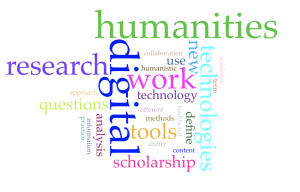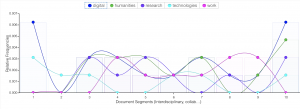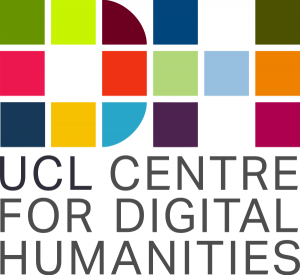Throughout the last few decades, the world has experienced a technological explosion. What I mean by this statement is that society is progressively becoming tech-savvy. As a result of recent trends, such as the rise of personal computing in the late 1980’s, society can now view the world through a new lens. These computers transformed the world into an environment reliant on the internet with audio, visuals, and graphics. Consequently, the field of Digital Humanities was created. What was once a civilization reliant on traditional literature, is now being transitioned to use visualization to offer additional interpretations to standard text.
Digital Humanities is changing a world in which knowledge was taught through texts and stationary pictures and progressing to a world that produces and organizes knowledge through graphic designs and more. Now, multiple authors can work collaboratively and efficiently through the new age of technology to create a product that adheres to human’s natural tendency to register shapes and patterns. However, any abrupt changes to society inevitably result in reluctant critics. These critics call upon an important question: What are the benefits and detriments of creating a digital artifact compared to an archival document?
An effective starting point to this argument would be to consider what ways digital versions of material texts highlight physical elements of texts that might otherwise pass unremarked. In his article “Visualizing the Archive”, Edward Whitley reflects upon how the human brain processes information. “Humans are quite adept at perceptual visual cues and recognizing subtle shape differences. In fact, it has been shown that humans can distinguish shape during the pre-attentive psychophysical process” (Whitley, 193). This fact entails that human brains are pre-wired to process and visualize shapes. While critics point out that traditional text encourages the reader to absorb the details of the material by reading more attentively, this benefit is outweighed when the text becomes too complex. The human brain can only take in a finite amount of information before details are lost. The Digital Humanities offer a solution to this problem by graphically displaying information that summarizes text in a way that’s easier on the human mind. By visualizing commonalities of the text, the viewer experiences serendipitous discovery of underlying themes that would have remained unapparent through standard text.
The picture below is from the project called “Lincoln at 200”. This project is connected to a website that allows the viewer to navigate through two website exhibitions. By adding structure to this website, the reader can view text documents in an organized manner. If it were a traditional text, the viewer would miss out on this organization leading to that person to interpret the reading less accurately. Using websites such as this one, scholars can create online reading interfaces that can more closely approximate the experience of reading physical materials.

On the other hand, literature provides some perks that computers can’t. Since computers were a recent invention, history is discovered through mainly literature. In the project called “Old Weather”, ship logs from the 19th and 20th century are vital for climate scientists. However, the handwriting can’t be processed by computers. Only the human eye can read these documents. The picture below is an example of one of these ship logs. By decrypting the text into modern English, not only can we sample the lives of these sailors, but scientists can grasp a better understanding of their climate.





